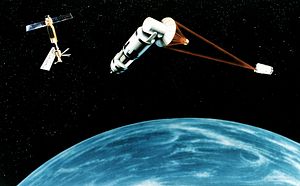This year, the Pentagon will try to step up its weapons modernization programs and boost investments in cutting-edge defense technology. As the principal rationale behind the Pentagon’s push, top Department of Defense officials cite the fear that the United States will lose its relative technological superiority thanks to the burgeoning technical capabilities of the Chinese and Russian militaries .
Yesterday, speaking at the McAleese/Credit Suisse Defense Programs Conference, Robert O. Work, deputy U.S. secretary of defense, noted that “because of budget uncertainty and restrictions imposed by Congress, and because of our unrelenting focus on the readiness of forward deployed forces, we’re chronically underinvesting in new weapons and capabilities.”
He further emphasized, “That should give all of us pause because our technological dominance is no longer assured (…) We see several nations developing capabilities that threaten to erode our long-assured technological overmatch and our ability to project power.” Chinese and Russian growing military capabilities are particularly worrisome for the Pentagon’s leadership.
The American military’s chief weapons buyer, Under Secretary of Defense for Acquisition, Technology and Logistics Frank Kendall, said during his presentation at the conference that the erosion of the U.S. technological edge in the space domain is “particularly bad” due to Chinese and Russian growing anti-satellite capabilities.
These capabilities potentially include cyber and electromagnetic attacks, jamming operations, and ground-based lasers as well as anti-satellite (ASAT) missiles. For example, China destroyed a defunct weather satellite with a missile in 2007. In addition, Beijing tested a missile-fired anti-satellite kill vehicle in the summer of 2014, disguising it as a ballistic missile defense test. Russia is allegedly developing a satellite hunter — a spacecraft able to track enemy satellites and destroy them — according to media reports.
U.S. officials are especially concerned about threats to U.S. Advanced Extremely High Frequency (AEHF) satellites. “If an adversary were to take out one, just one satellite in the constellation, a geographic hole is opened and we potentially have a situation where the president can’t communicate with forces in that part of the world,” one official underlined.
However, many analysts note that the current threat scenarios have much more to do with the ongoing debate about sequestration — across the board budget cuts — and the fiscal year 2016 defense budget request (see: “The Defense Budget Debate Rages On”) than the actual danger to U.S. satellites from Chinese and Russian weapons.
As Diplomat contributor Jaganath Sankaran noted back in 2014: “While these concerns have some validity, all U.S. military satellites are not equally vulnerable to a Chinese ASAT attack. Furthermore, the benefits from an ASAT attack are limited and would not confer decisive military advantage in every plausible conflict.”
“The substantial range of orbital altitude — 1,000 kilometers to 36,000 kilometers — from which satellites operate poses a challenge to China’s ability to attack U.S. military satellites (…) Unlike the U.S., China has a very limited satellite tracking capability, most of which are based in its territory and possibly a few ships,” he adds.
More importantly he emphasized that “the presence of alternate platforms and built-in redundancies substantially limit the advantages that China can obtain from anti-satellite operation against the U.S.”
In November 2014, the Pentagon launched the Defense Innovation Initiative (DII), an initiative to maintain America’s military dominance for the 21st century and to develop a new third offset strategy. “The DII’s leading focus is to identify, develop and field breakthrough technologies and systems and to develop innovative operational concepts to help us use our current capabilities in new and creative ways,” Deputy Secretary Work said.
































